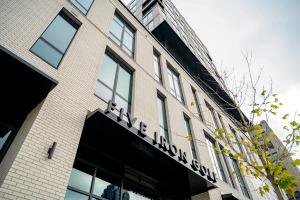Subscriber Benefit
As a subscriber you can listen to articles at work, in the car, or while you work out. Subscribe Now
Indianapolis-area brokers are bullish on the future of the local retail sector as occupancy rates grow in the aftermath of the pandemic and demand for space outstrips supply in some suburbs.
The industry’s inventory has been generally stable in the wake of the pandemic. In fact, retail stock has increased slightly from 46.3 million square feet in the first quarter of 2020 to just over 46.6 million during the same time frame this year, according to data from the Indianapolis office of Chicago-based brokerage Cushman & Wakefield.
The figures account for shopping centers only; they do not include mixed-use developments, retail outlots or stand-alone box stores.

Bill French, executive director and retail broker for Cushman & Wakefield, said “the retail sector is performing extraordinarily well” given the circumstances of the past three years.
His assessment is based in part on another key category: vacancies. The overall vacancy rate for the Indianapolis area was 5.5% in this year’s third quarter, with submarkets like Avon, Fishers, Mooresville and the Nora neighborhood of Indianapolis having little or no available space for would-be users.
It’s a full percentage point higher than the third quarter of 2019 (4.5%) but a marked improvement from the 6.5% vacancy during the same period in 2021. The figure in 2022 was 5.2%.
“It’s pretty amazing that there’s very limited vacancy throughout the market,” French said, adding that anecdotal evidence leads Cushman & Wakefield to believe overall vacancy might be as low as 5% now.
A return to pre-pandemic figures in that category has been prolonged by online shopping habits, a stronger focus on other uses for former retail space—such as indoor entertainment—and an emphasis by developers on mixed-use projects, which typically have less retail space than traditional shopping centers.

Robyn Swihart is owner and managing broker of Indianapolis-based retail real estate company Equivis Realty. She said the low vacancy rates are being driven by interest in certain submarkets, with some clients going to extremes to gain an edge.
“We’re in a really competitive cycle right now, with a lot of retailers vying for the same few spaces,” she said. “In desirable trade areas, our clients are submitting offers to lease on spaces that are still occupied but that are coming available in the next 12 months, to get a competitive edge and because the current availabilities do not meet their needs.”
That’s led to a continued rise in rent in many areas, with the average asking price bumping from $15.13 per square foot per year in 2022 to $15.56 today. In a spot like Glendale, the asking rate has been closer to $30 per square foot. In Carmel, it’s been $24.
But the asking rent in Mooresville—with vacancy of only 1.7%—was only $8 per foot in the third quarter. In Fishers, with a vacancy of 1.6%, it was under $14. Other submarkets like Pendleton Pike and Washington Square, both on the east side, continue to struggle in commanding high rents, despite low inventory levels.
A push for more
Swihart said one major factor keeping inventory low is the slowdown in construction, largely because of material and labor costs and the price of debt. Right now, only about 14,000 square feet of new shopping center space is underway, compared with nearly 770,000 square feet in the first quarter of the pandemic, according to Cushman & Wakefield.
All of that construction is occurring in Greenwood and Carmel. But Swihart said the lack of new inventory makes expansion for existing companies challenging and new entry to any spot in the market next to impossible.
“I think it’s a pretty hot market right now, because retailer sales are still strong and they’re still looking to grow,” she said. “There’s just not that much space available.”
Anecdotally, Swihart said, most new inventory coming online seems to be part of mixed-use developments, which are not accounted for in Cushman & Wakefield’s data.
French said those projects can be beneficial to an extent, but standard shopping centers tend to perform better—particularly in areas of lower density. He said mixed-use developments tend to result in higher retail vacancies, but they are easier to finance than stand-alone shopping centers.

“Retailers tend to perform significantly better in true retail shopping environments,” he said. “Mixed-use can be good for a smaller coffee shop or sandwich shop. But in a lot of cases, it’s not” advantageous.
Jacque Haynes, senior associate at Indianapolis-based development firm and brokerage Midland Atlantic Properties, said she sees mixed-use projects as more of a long-term urban play than one for the suburbs.
Shopping shifts
While the pandemic sent consumers scurrying to online shopping sites like Amazon and Wayfair, many have found their way back to stores. On Black Friday, although few local stores saw the pre-pandemic swell of shoppers outside their front doors before opening, crowds surged in the late morning and early afternoon.
But retailers have also learned to lean into online shopping specials and have done away with some in-store gimmicks and “doorbusters,” in favor of promotions that push web traffic and sales.
“It’s just changed how retailers operate,” Swihart said.
Many shopping centers are continuing to perform well—particularly those of the open-air variety. In fact, Kite Realty Group Trust, an Indianapolis-based development firm, has invested tens of millions of dollars since the pandemic began to overhaul several of its local holdings.
The company told IBJ in mid-2019 it planned to spend $15 million to redevelop the former Macy’s space at Glendale Town Center into four stores, splitting 53,000 square feet on the second floor (which technically is street level on the south side of the mall that faces Target) into four stores with separate exterior entrances. That project was completed during the pandemic, along with a $40 million apartment complex called Ayr that was developed in partnership with local firm Milhaus.

“We continue to invest in our centers, because our real estate is our product,” said Bryan McCarthy, vice president of communications for Kite. “Our continued investment in our assets has been beneficial for all involved. Retail is strong, demand for space at our shopping centers is incredibly high, and retailers have determined that having a physical footprint is a critical part of their platform.”
The company is also redeveloping the site of a 1970s-era retail center at the southwest corner of East 116th Street and Rangeline Road into a mixed-use project consisting of up to 285 apartments, more than 25,000 square feet of retail and a parking garage. That $69 million project is set to open next year.
Kite this year completed an upscale modernization of the 65-year-old Nora Plaza on East 86th Street near College Avenue. The improvements—which included updating utilities, signage and infrastructure—led to the exit of four longtime tenants, including Goodman’s Shoes. Kite acquired the property for $29 million in 2022.
McCarthy said the pandemic fast-tracked companies’ strategies to offer shoppers more options.
“The pandemic accelerated many behaviors and processes that rely on and benefit physical retail and the shopper experience,” he said, pointing to stores as distribution points and the use of curbside pickup and store pickup as primary examples.
Downtown retail
One submarket that continues to face questions long term, in terms of both occupancy and inventory, is downtown. It has faced a deluge of challenges, including a lack of consensus on return-to-office policies and uncertainty over the long-term viability of some neighborhoods.

Robert Coombes, owner of Coombes Real Estate, said he’s optimistic downtown will bounce back, pointing to the success of pockets like the Bottleworks District and The Stutz in melding retail and office. He said those types of developments will continue to succeed.
But he added the future of downtown retail will hinge on the success of not only standard street fronts like Meridian and Georgia streets but also projects like Eleven Park.
The $1.5 billion project planned for the former Diamond Chain Manufacturing Co. west of Lucas Oil Stadium is expected to include 197,000 square feet of retail and restaurant space as part of a 20-acre development focused on a soccer stadium. Coombes said the revamp of Circle Centre Mall will also be critical to downtown’s future as a retail hub; details of that project remain under wraps.
“I think that [the suburbs] are doing extremely well, but downtown is still struggling a bit,” he said. “There’s a lot there to be worked out.”
French agreed, adding that the city’s tourism arm, Visit Indy, has been able to keep many retailers afloat by drawing a strong slate of conventions to town since the pandemic. French is a board member of Visit Indy.
“There aren’t as many [office workers] now that are coming to downtown to spend dollars,” he said. “Thankfully, our good friends at Visit Indy have been just crushing it, doing a fantastic job of keeping existing and bringing new conventions to town.”

This month, a New York City-based golf simulator company called Five Iron plans to open its first Indianapolis location as part of Industry Indy, a new apartment property at 421 N. Pennsylvania St. The 12-story, 230-unit apartment property will feature Five Iron as its anchor tenant. The entertainment company offers virtual, simulated golf bays for individuals and groups. It also features a full bar and restaurant.
Scott Schmelzer, general manager of the Indianapolis Five Iron, said the downtown location “is a really good fit” for the company because it will be able to draw not only large groups but also downtown office workers and others who are spending time in the city’s central business district.
“Even after COVID, we didn’t shy away from downtowns,” he said. “We still believe in that vision, especially as downtowns continue to climb their way back—we want to be a part of that.•
Please enable JavaScript to view this content.


One suburban retail center not doing to well is Trader’s Point. Several vacancies and when Dick’s leaves will be a huge void. A grocery store where Marsh was once located is also needed at this location.
Yeah, I don’t live in that area but went by there the other day on my way to Tox Drop and was shocked at the current state of Traders Point. Wonder what the issue is?
The lack of residential population in the immediate area is a problem.
Still experiencing a lot of hesitation in small market due to fear of economy and government upheaval. TRUST is the key word for retailers especially the mom & Pop or smaller operators due to staffing, and supply chain issues. They get to the threshold and back down on commitment to lease due to trust forecast. At least that is our experience in a small niche market.